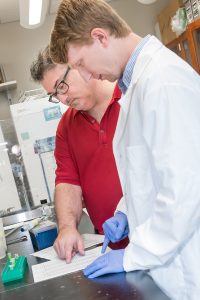
Diseases have a spectrum of risk, even those partially embedded in genes such as Parkinson’s disease.
Less than 10 percent of those with Parkinson’s can pinpoint their genes as the only culprit, while scores of others with some genetic markers are diagnosed with the disease. Still others have markers to develop Parkinson’s, but do not.
Why? Research underway at The University of Alabama, supported by the National Institutes of Health, hopes to identify factors and methods through which individuals are either resilient or susceptible to the neurodegeneration in the brain as part of the disease.
“If we can pinpoint some of the factors that cause this distinction in resilience, then we can use them as a new therapeutic angle,” said Dr. Guy Caldwell, University Distinguished Research Professor in biological sciences.
Caldwell, along with doctoral student Brucker Nourse, a native of Nashville, Tennessee, will work with tiny roundworms known as C. elegans, which share roughly half their genes with humans. Its basic features allow inexpensive and rapid testing for a range of neurological diseases, and UA researchers can induce Parkinson’s-like effects in the worm for testing.
Since the worms all have an identical genetic code, Caldwell and Nourse are investigating how the genes of the worm are modified, or expressed. The turning off and on of genes from outside forces is known as epigenetics, and how external factors influence genetic performance is a big part of disease research, Caldwell said.
“That combination of regulating epigenetics and regulating dopamine levels and functions is the big mystery of Parkinson’s. We really think this is a nexus of what might happen,” Caldwell said. “There’s promise there that if you can find a molecule to modulate that mechanism, and it crosses the blood-brain barrier, it might work at halting progression of the disease.”
The NIH grant of $425,000 supporting the work lasts for three years.
Learn more about Dr. Caldwell’s research by reading the full article on the UA news site.